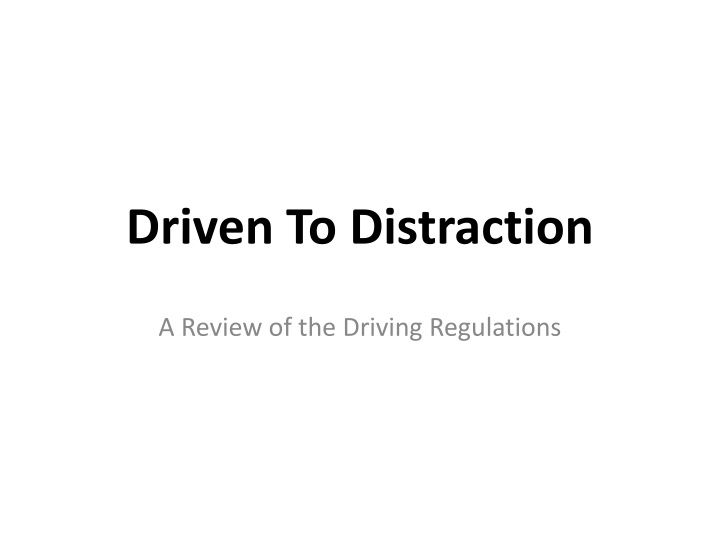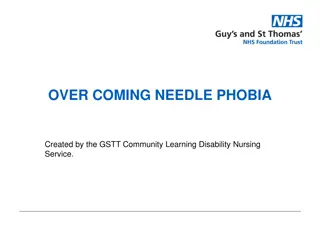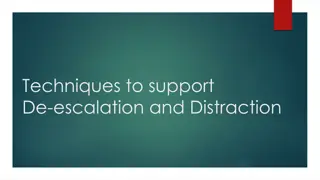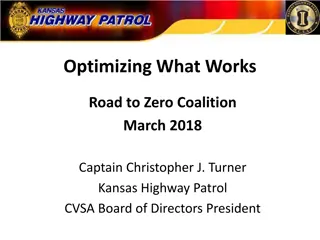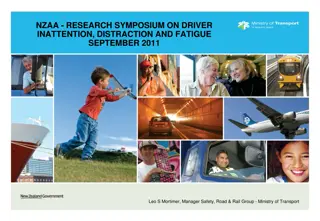Driven To Distraction
In this review, explore obligations regarding fitness to drive and learn about DVLA recommendations for medical conditions. Understand how to handle patients deemed unfit to drive and their refusal to comply.
Download Presentation

Please find below an Image/Link to download the presentation.
The content on the website is provided AS IS for your information and personal use only. It may not be sold, licensed, or shared on other websites without obtaining consent from the author.If you encounter any issues during the download, it is possible that the publisher has removed the file from their server.
You are allowed to download the files provided on this website for personal or commercial use, subject to the condition that they are used lawfully. All files are the property of their respective owners.
The content on the website is provided AS IS for your information and personal use only. It may not be sold, licensed, or shared on other websites without obtaining consent from the author.
E N D
Presentation Transcript
Driven To Distraction A Review of the Driving Regulations
Objectives Consider our obligations with regard to fitness to drive Look at DVLA recommendations for certain medical conditions that might be encountered in the ED Get some exercise!
Q1. What is our initial obligation when dealing with a patient who is deemed unfit to drive? 1. Take away their car keys. 2. Tell the patient they are unfit to drive. 3. Inform the DVLA of the decision. 4. Tell the patient to inform the DVLA.
Q1. What is our initial obligation when dealing with a patient who is deemed unfit to drive? 1. Take away their car keys. 2. Tell the patient they are unfit to drive. 3. Inform the DVLA of the decision. 4. Tell the patient to inform the DVLA.
Q2. The patient says he disagrees with your opinion. Do you: 1. Shrug your shoulders and say, It s your funeral mate. 2. Take away their car keys. 3. Inform the DVLA. 4. Offer to arrange a second opinion.
Q2. The patient says he disagrees with your opinion. Do you: 1. Shrug your shoulders and say, It s your funeral mate. 2. Take away their car keys. 3. Inform the DVLA. 4. Offer to arrange a second opinion.
Q3. The patient refuses a second opinion and insists on driving home. Do you: 1. Inform the DVLA. 2. Take away their car keys. 3. Call the police. 4. Restrain the patient.
Q3. The patient refuses a second opinion and insists on driving home. Do you: 1. Inform the DVLA. 2. Take away their car keys. 3. Call the police. 4. Restrain the patient.
Case 1: 60 year old hypertensive man presents with right shoulder pain from capsulitis. An ECG has been done routinely showing LBBB. He has never had any chest pain. 1. 6 months 2. 4 weeks 3. No restriction 4. 3 months
Case 1: 60 year old hypertensive man presents with right shoulder pain from capsulitis. An ECG has been done routinely showing LBBB. He has never had any chest pain. 1. 6 months 2. 4 weeks 3. No restriction 4. 3 months
Case 2: 25 year old woman with history of epilepsy usually well-controlled. Attends following single seizure lasting for 5 minutes resolving spontaneously. Now fully recovered. 1. No restriction 2. 1 year 3. 6 months 4. 3 months
Case 2: 25 year old woman with history of epilepsy usually well-controlled. Attends following single seizure lasting for 5 minutes resolving spontaneously. Now fully recovered. 1. No restriction 2. 1 year 3. 6 months 4. 3 months
Case 3: You discover the patient outlined in Case 2 is an HGV driver. 1. 10 years 2. 5 years 3. 1 year 4. 6 months
Case 3: You discover the patient outlined in Case 2 is an HGV driver. 1. 10 years 2. 5 years 3. 1 year 4. 6 months
Case 4: 63 year old woman, no past medical history, felt hot, sweaty, dizzy while standing up in church for a hymn and suffered loss of consciousness of 3 minutes. Fully recovered, no features to suggest seizure. ECG normal. 1. 1 year 2. 6 months 3. 1 month 4. No restriction
Case 4: 63 year old woman, no past medical history, felt hot, sweaty, dizzy while standing up in church for a hymn and suffered loss of consciousness of 3 minutes. Fully recovered, no features to suggest seizure. ECG normal. 1. 1 year 2. 6 months 3. 1 month 4. No restriction
Case 5: Same patient as previous has a second episode of loss of consciousness 1 month later, this time while sitting down. 1. 1 year 2. 6 months 3. 1 month 4. No restriction
Case 5: Same patient as previous has a second episode of loss of consciousness 1 month later, this time while sitting down. 1. 1 year 2. 6 months 3. 1 month 4. No restriction
Case 6: 45 year old HGV driver has an episode of loss of consciousness while driving which lasted 5 minutes with full recovery. No obvious cause. 1. Banned for life 2. 10 years 3. 5 years 4. 1 year
Case 6: 45 year old HGV driver has an episode of loss of consciousness while driving which lasted 5 minutes with full recovery. No obvious cause. 1. Banned for life 2. 10 years 3. 5 years 4. 1 year
Case 7: 58 year old man fell through loft floor suffering abdominal injury. On FAST no free fluid but incidental AAA 6.8cm found. 1. No restriction 2. 6 months 3. 1 year 4. Banned until treated
Case 7: 58 year old man fell through loft floor suffering abdominal injury. On FAST no free fluid but incidental AAA 6.8cm found. 1. No restriction 2. 6 months 3. 1 year 4. Banned until treated
Case 8: 19 year old woman with first unprovoked seizure lasting 10 minutes. Fully recovered. No injury. 1. 1 year 2. 6 months 3. 3 months 4. 1 month
Case 8: 19 year old woman with first unprovoked seizure lasting 10 minutes. Fully recovered. No injury. 1. 1 year 2. 6 months 3. 3 months 4. 1 month
Case 9: 45 year old woman presenting with single episode of presumed cough syncope. 1. No restriction (on cough sweets??) 2. 1 year 3. 6 months 4. 4 weeks
Case 9: 45 year old woman presenting with single episode of presumed cough syncope. 1. No restriction (on cough sweets??) 2. 1 year 3. 6 months 4. 4 weeks
Case 10: 56 year old man presents with a 3 day history of left homonymous hemianopia which is found to be due to a CVA. No other neurological deficit. 1. Banned for life 2. 5 years 3. 1 year 4. 6 months
Case 10: 56 year old man presents with a 3 day history of left homonymous hemianopia which is found to be due to a CVA. No other neurological deficit. 1. Banned for life 2. 5 years 3. 1 year 4. 6 months
Case 11: GP sends in a 32 year old man with mildly deranged LFTs, thrombocytopenia and macrocytosis. On questioning he admits to drinking half litre of vodka per day for 6 months. He never has the shakes. 1. 1 year 2. 6 months 3. 1 month 4. No restriction
Case 11: GP sends in a 32 year old man with mildly deranged LFTs, thromboctopenia and macrocytosis. On questioning he admits to drinking half litre of vodka per day for 6 months. He never has the shakes. 1. 1 year 2. 6 months 3. 1 month 4. No restriction
Case 12: 24 year old paramedic is newly diagnosed with diabetes mellitus and is started on insulin. 1. Banned for life 2. 6 months 3. 1 month 4. Banned until condition stable
Case 12: 24 year old paramedic is newly diagnosed with diabetes mellitus and is started on insulin. 1. Banned for life 2. 6 months 3. 1 month 4. Banned until condition stable
Case 13: 22 year old woman admits to withdrawal symptoms when trying to kick a 2 year ketamine habit. 1. No restriction 2. 1 year 3. 6 months 4. As soon as drug free
Case 13: 22 year old woman admits to withdrawal symptoms when trying to kick a 2 year ketamine habit. 1. No restriction 2. 1 year 3. 6 months 4. As soon as drug free
Case 14: 48 year old HGV driver has fully recovered from TIA with right hemiparesis. Normal ECG. 1. 5 years 2. 1 year 3. 6 months 4. 3 months
Case 14: 48 year old HGV driver has fully recovered from TIA with right hemiparesis. Normal ECG. 1. 5 years 2. 1 year 3. 6 months 4. 3 months
Case 15: 20 year old man presents 2 days after an assault with persisting headache, blurred vision. A CT head shows some left frontal contusions not requiring any treatment. 1. No restriction 2. 4 weeks 3. 3 months 4. 6 months
Case 15: 20 year old man presents 2 days after an assault with persisting headache, blurred vision. A CT head shows some left frontal contusions not requiring any treatment. 1. No restriction 2. 4 weeks 3. 3 months 4. 6 months
Case 17: 34 year old diabetic attends with hypoglycaemic episode requiring her husband to administer Hypostop. 1. No restriction 2. 4 weeks 3. 3 months 4. 1 year
Case 17: 34 year old diabetic attends with hypoglycaemic episode requiring her husband to administer Hypostop. 1. No restriction 2. 4 weeks 3. 3 months 4. 1 year
Case 18: Same woman presents 1 month later with further episode of hypoglycaemia requiring husband to administer Hypostop. 1. No restriction 2. 4 weeks 3. 3 months 4. 1 year
Case 18: Same woman presents 1 month later with further episode of hypoglycaemia requiring husband to administer Hypostop. 1. No restriction 2. 4 weeks 3. 3 months 4. 1 year
Case 19: 66 year old man with implantable defibrillator for 2 years. It has delivered a single shock and the patient is well on arrival in ED. ECG now shows normal sinus rhythm. 1. Banned for life 2. 1 year 3. 6 months 4. 1 month
Case 19: 66 year old man with implantable defibrillator for 2 years. It has delivered a single shock and the patient is well on arrival in ED. ECG now shows normal sinus rhythm. 1. Banned for life 2. 1 year 3. 6 months 4. 1 month
Case 20: 52 year old HGV driver is in withdrawal. He admits to drinking 2 litres of White Lightning a day. 1. Banned for life 2. 10 years 3. 3 years 4. 1 year
Case 20: 52 year old HGV driver is in withdrawal. He admits to drinking 2 litres of White Lightning a day. 1. Banned for life 2. 10 years 3. 3 years 4. 1 year
Summary Legal and ethical obligations with regard to fitness to drive Looked at several cases and the relevant DVLA advice Got a dead arm
